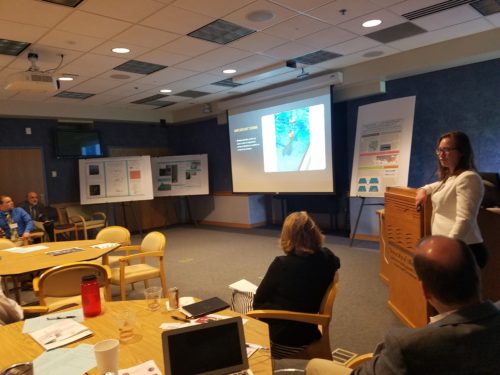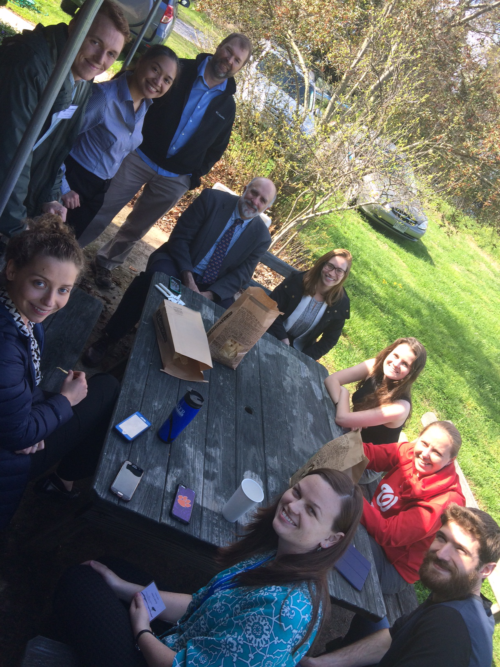Hello and Goodbye: The brief in-person encounter with my online class
Claire Sbardella ·I met with my Science Visualization classmates in person for the first time at the Maryland Chapter of the American Planning Association workshop: Translating science for comprehensive and environmental plans, held at the Aquaculture and Restoration Ecology Laboratory at the Horn Point Laboratory. The goal of this workshop was to explore potential strategies for implementing science into property planning and facilitating community engagement. We listened to the many talented and knowledgeable presenters before demonstrating our own presentations, which represented the culmination of all of our knowledge gathered throughout the semester. Bill Dennison, our teacher, introduced us.
For me personally this workshop was bittersweet: sweet because us classmates finally got to meet each other, and bitter because it was also the last time we would meet outside of our online class.
The workshop began with an aquaculture tour and opening remarks. Keynote speaker Dr. Josh Ginsberg gave a talk. After Dr. Ginsberg finished, we had six other presenters, whose expertise stemmed both from planning backgrounds and from scientific ones. Because of this variety, we got to see environmental dilemmas tackled from both perspectives. Dr. Ming Li, an UMCES professor, outlined the potential future threats to the Maryland coast and emphasized the need to focus resources on protecting the coastlines. Brian Ambrette outlined how his group, the Eastern shore climate adaptation partnership (ESCAP), goes beyond science and into concrete deliverables to help with shoreline management. The other speakers, Zoe Johnson, Peter Claggett, Rich Hall and Lisa Craig, examined similar themes in their presentations.

After lunch, us science visualization students presented. Watching my classmates walk up to the podium and present their PowerPoints, videos, and posters that I saw them work so hard on throughout the semester, I teared up just a little bit. Not much. But this was the crescendo of our class, everything else afterwards is just tying up loose ends. I took pictures like it was my job (it was, I was the blogger), and wrote down notes. While not everyone could be there to present, their work was still displayed for the audience. Here is a run-down of all of my classmates’ presentations.
Nicole Basenback – Using a model to explore nutrient load timing effects on water quality in the Chesapeake Bay. Nichole used a powerpoint to tell her story.
Tom Butler – Problem solving with computer models in Chesapeake Bay. He used video format to explain models, how they work, and examples of how they are useful.
Annie Carew – Genotypic diversity increases productivity and resilience of aquatic vegetation populations. Annie used a poster to demonstrate her findings on the SAV hydrilla, an invasive species that may still hold the key to helping prevent shoreline erosion.
Jamie Currie – Transformation of Moreton Bay. Jamie sent in a video from Australia. It was an interview spliced with footage from the Moreton Bay.
Katie Fitzenreiter – The modernized “message in a bottle:” revealing circulation patterns in Maryland's coastal waters using gps-equipped surface drifters. Katie presented a powerpoint that showed the patterns that her surface drifters showed.

Alyssa Houde – Map projections: more than 70 different ways to view the world. Alyssa’s video was especially appreciated for her example, using an orange peel, of how maps could be distorted when put on a flat surface.
Lexy McCarty – Breeding an oyster for Maryland: what is the genetic framework underlying low-salinity tolerance? This video indicated in simple terms the complexities of cross-breeding oysters.
Natalie Peyronnin – Using lessons learned from the great barrier reef of the Americas to transition the future of coastal marshes. Natalie was unable to join us in person, but Bill explained her poster.
Erin Reilly – Longer term monitoring after a marsh restoration is crucial for recognizing success, fixing problems, and monitoring continuing threats. Erin's poster told the story outlined in her title in a very straightforward way.
Claire Sbardella (me) – Maryland coastal bays program annual review. I used a video to tell my story about the Maryland Coastal Bays.
Jessie Todd – Utilizing adobe illustrator. This video focused on what we learned in class, specifically on the visualization abilities of adobe Illustrator.
Chelsea Wegner – Ecosystem response to declining sea ice. Chelsea, although unable to be present, had a very well-created video.
Rebecca Wenker – Corals in the mid-Atlantic – Yes, they do exist! This surprisingly beautiful and soothing video showed Rebecca’s research into mid-Atlantic corals.

As you can see, there is a lot of variety in my classmate’s work, but they all had one thing in common: they used the tools learned in in our Science Visualization class to create visually stunning PowerPoints, posters and videos. While all formats were used to create powerful visuals and clear stories about science, the videos, due to their additional audio, were especially powerful in their use of ABT, descriptive visuals, and the use of narration and music. However, each type of presentation thoroughly exhibited the tools that we learned to communicate science.
After the workshop ended, we had a small get-together at the Horn Point Bathhouse. There we made small talk and relaxed after our full, eventful day. We also got to know each other a little bit beyond academia and the classroom setting, and that was a lot of fun. Even though I was exhausted, I still enjoyed the meetup immensely.

In conclusion, the workshop had a lot of insightful speakers, and I am glad our class got to demonstrate our skills to this group of highly trained and accomplished people. They got a chance to learn about new research from young scientists and see examples of science communication that they could use in their own communications to the public. We got to practice communicating our science to a new audience. In a way, because we all received critiques as we went along, it prepared us a lot more for the questions that we received from the audience. I enjoyed the journey of watching my classmates hone their skills and create their final projects, and I will miss that small community. I hope that my classmates continue to grow in their science communications skills as they continue down the path of academia!
Next Post > Future Earth Coasts workshop songbook
Comments
-
Nicole Basenback 6 years ago
Great blog Claire, I liked how you focused on the application of what we have learned in class and how these tools can be applied to such a broad range of products and research interests. This was a great class and I learned so much that I will be able to continuing applying on my science journey. Thanks IAN!
-
Alyssa Wellman Houde 6 years ago
This post had me tearing up a little bit too - I so wish I could have been there to meet you all in person. This has been a great experience, and your blog did a great job of encapsulating the breadth of and amount of work everyone has put in this semester! I can't speak for anyone else, but in know I learned so many different tools that will come in handy moving forward.
-
Natalie Peyronnin 6 years ago
I got teary eyed from your blog that I couldn't be there. I'm having serious post-FOMO. But so glad it went well and everyone did so well. The products produced were very impressive.
-
Rebecca Wenker 6 years ago
I really enjoyed this blog, and the workshop! It was nice to see the culmination of everyone's work this semester. I was also glad to meet (almost) everybody in person. I thought you did a good job describing the presentations, and gave everybody a chance to shine. Hopefully I'll see everyone at the MEES Colloquium next fall!
-
Lexy McCarty 6 years ago
LOVE this blog. Wished I could have been there to meet you all, but I feel like I was there from reading this - loved the summary of the conference and the play-by-play! Also, really enjoyed how you included each person's title highlighting how we all study very different things, and then brought us all together at the end through our newly developed skills. Feel like our whole semester is wrapped up (tear). Great work!
-
Tom Butler 6 years ago
Claire, this must have been the blog equivalent to Bambi, you're really tugging at my heart strings. In order to create a sillier mood I'd like to draw attention to Jessie in the earlier picture, eyes open please! I very much enjoyed the summary of the conference. You described, very well, how our work related to the conference. I would like to reiterate your point about the diverse backgrounds of everyone in the class and how despite this we each learned how to communicate our main message. Great job!
-
Bill Dennison 6 years ago
Claire’s blog about our in person class session as part of the Maryland chapter of the American Planning Association workshop at Horn Point Laboratory was indeed the first (and last) time our Science Visualization class would gather in person. Thus, the appropriate title of Claire’s blog: Hello and Goodbye. The obvious song choice from this title was the Beatles’ song Hello Goodbye, and my version is as follows:
Hello Goodbye
2 May 2018
William C. DennisonYou say "Yes", I say "No".
You say "Stop" and I say "Go, go, go".
Oh no.
You say "Goodbye" and I say "Hello, hello, hello".
I don't know why you say "Goodbye", I say "Hello, hello, hello".
I don't know why you say goodbye, I say hello.I say "Powerpoint", you say "Video".
You say "Why?" And I say "I don't know".
Oh no.
You say "Visual" and I say "Photo, photo, photo".
I don't know why you say "Map it", I say "GIS, GIS, GIS".
(Hello, goodbye, hello, goodbye. Hello, goodbye.)
I don't know why you say "Conceptual", I say "Diagram".
(Conceptual, diagram. Conceptual, diagram. Conceptual, diagram. Conceptual, diagram.)
Why, why, why, why, why, why, do you
Say "Goodbye, goodbye, bye, bye".
Oh no.
You say "Goodbye" and I say "Hello, hello, hello".
I don't know why you say "Goodbye", I say "Hello, hello, hello".
I don't know why you say "Goodbye", I say "Hello". -
Jessie Todd 6 years ago
Hey, Tom, we cannot all be picture perfect. Claire, I really loved your blog and how it wraps up our semester and highlights that we have been communicating via the internet for an entire semester. I think it so key to be able to meet in person and share what we have been working on throughout the semester and to be able to listen to other experts in their field of knowledge.
-
Chelsea Wegner 6 years ago
Nice job on the blog, Claire. You gave it a much more personal touch than any others this semester. I'm just sorry I wasn't able to be there in person! Sounds like it went really well.
-
Atika 6 months ago
Thank you for sharing this great information with us, i really appreciate your post!